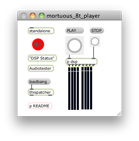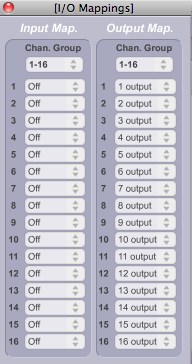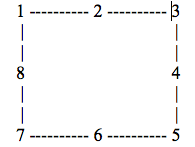Table of contents
Performance date: 14 juillet 2012
Documentation date: 7 janvier 2013
Version state
Valid
Validation date: 3 mai 2018
Executions dates of this version
- 14 juillet 2012,
Version documentalist
- nouno (Gilbert.Nouno@ircam.fr)
Version realisation
- Gilbert Nouno (Computer Music Designer)
Other version(s)
Channel details
- Number of output channel : 8
Electronic equipment list
Computer Music Equipment
-
1 MacBook Pro - Apple Laptops
(Apple)
-
1 Max 5 - Max
(Cycling74)
-
1 Fireface 400 - Sound Board
(RME)
or equivalent 8 output
Audio Equipment
-
8 Loudspeaker - Loudspeakers
Work related information
Premiere
- 30 novembre 1980, <p>France, festival de Lille.</p>
Publisher :
- Faber Music
Realisation
- Stanley Haynes
Work length
- 9 mn
Useful links on Brahms
- Mortuos plango, vivos voco pour sons concrets traités par ordinateur (1980), 9mn
- Jonathan Harvey
| File | Author(s) | Comment | |
|---|---|---|---|
| Download [246,4 Mio] | Patch MortuosPlango.dmg | Gilbert Nouno | the patch + audio to run the piece |
| Download [154,5 Kio] | Document Mortuos Plango.doc | Gilbert Nouno | patch instructions doc word |
| Download [164,2 Kio] | Document Mortuos Plango patch instruction.pdf | Gilbert Nouno | patch instructions pdf |
Instructions
Software Installation
The electronic part of Mortuos Plango, Vivos Voco is performed with the following patch :
mortuos_8t_player (as a standalone application)
Or with the patch mortuos_8t_player.maxpat (the max5 patch)
Run either the application or the patch with a valid Max5 application, you will have the following window :

DSP Overview
The following diagram shows the max DSP status and audio configuration, you can access them in the « DSP Status » subpatch of the mortuous_8t_player.
Set each output on the 8 loudspeakers output you will be using


Using the patch
Turn the DSP on ( Red loudspeaker icon).
Press the “play” button.
You should ear the sound and watch the level meters moving like in the following picture.

Session Digital Performer
If you are using the Digital Performer software, you can open the session and play it directly within the sequencer, provided you set the right output channels.
Loudspeaker configuration
Here is a top view of the 8 loudspeakers.

© IRCAM

This documentation is licensed under a Creative Commons Attribution-NonCommercial-NoDerivatives 4.0 International License.
Program note
Cette œuvre reflète mes expériences à la cathédrale de Winchester où mon fils Dominique a été choriste de 1975 à 1980. Elle est fondée sur sa voix et sur celle de la grande cloche ténor. Cette énorme cloche noire d'une puissance surhumaine porte en inscription : « Horas avolantes numero mortuos plango : vivos ad preces voco » (« Je compte les heures qui s'enfuient, je pleure les morts : j'appelle les vivants à la prière »). Ce texte est repris par la voix du jeune garçon. La hauteur et la structure temporelle de mon oeuvre sont entièrement fondées sur le spectre très riche et harmoniquement irrégulier de la cloche, structure qui n'est ni tonale, ni dodécaphonique, ni modale à la manière occidentale ou orientale mais tout à fait unique.
Les huit sections de l'œuvre reposent chacune sur l'un des huit principaux partiels les plus bas. Les accords sont construits à partir d'un répertoire de 33 partiels ; les modulations entre les différentes zones du spectre sont effectuées par des glissandi.
Des transformations constantes entre le spectre d'une voyelle chantée et celui de la cloche sont réalisées par des manipulations sur les composantes internes des deux sons. Il faut imaginer que les murs de la salle de concerts enserrent le public comme les côtés de la cloche autour de laquelle vole librement l'âme du jeune garçon (cet effet est surtout perceptible dans la version originale huit pistes).
Jonathan Harvey.
Version documentation creation date: 4 janvier 2013 16:24, update date: 14 octobre 2021 15:12